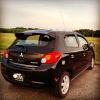I get what you are saying, but I teach how to properly use a parking/emergency brake several times a week. I honestly believe these new electric parking brakes are a safety risk, but maybe all the other sensors will save one long before anyone is killed?
Many older vehicles that never offered a manual transmission option have a foot operated parking brake like your Dodge Ram. My 2015 Impala that I will be using for instruction later today is also set up that way. Why? An Impala has never offered an manual transmission option. At least not in my memory, and the earliest one I remember was my dad's 1966 Impala, and I took my driving test with my dad's 1977 Impala.
Most vehicles that offer a manual transmission option will have a hand parking brake, and there is a very specific reason for that, too. Our Ford Focus driving car is set up that way even though it's an dual-clutch automatic (piece of crap). My manual Forester & Mirage are set up that way along with all CVT Mirages I would guess. The reason for a hand parking brake in these vehicles is because they offered a manual option at one time or somewhere in the world market.
So my first big concern is this - If one's main brakes should actually fail in a real life situation & I have seen it happen, do I want an emergency brake that is a button & instantly locks up your brakes/wheels or do want a pedal or lever that allows you to bring the car to slow, steady, controlled stop? With an electric parking brake that option is lost. With a manual emergency brake, I can still slam it hard if I really need to, but I can also take control of the situation. We have to much junk on new cars, and this is a big one in my opinion. It's a step backwards.
The main reason for a hand parking brake for manual vehicles (before Hill Start Assist existed - another maybe worthless feature) is the control it gives you when parking on a steep hill. I only have two feet, but I could use three feet in this situation. That's where your right hand comes in. I can left out my clutch with left foot, move my right foot from the brake to the gas pedal, while holding the vehicle in place with the parking brake in right hand. As I feel the clutch engage with my left foot & give the car a little gas with my right foot, I can slowly time my release of the parking brake. It takes practice and coordination of course.
Now, someone who's been driving a manual for years can probably pull all this off without using the hand brake at all, but it is a valuable option just the same. Most of us that are use to driving a manual are going to engage the clutch slightly while moving our right foot the gas pedal. Some struggle with that. Rolling back into someone/something is never good!
An automatic vehicle is not going to have that concern. My students are taught when they release the parking brake on the Impala with their left foot, their right foot is planted firmly on the main brake pedal. Once the parking brake is released, their left foot will now join their right foot (reason for wider brake pedal on automatic vehicles maybe?). it's the only time I allow them to use their left on the brake pedal. Now their right foot is free to move the gas pedal with no fear of rolling back, because they are holding the car in place with their left on the brake. I can't do that when my left foot is releasing the clutch pedal on a manual.
I will teaching this to students tonight, and I will have a new driving instructor in training observing all this with me. We have very steep hills in our area (even in town). RC doesn't have a water tower like most towns. Our water tank is on the steepest hill on the edge of town. You live below that tank, you have water pressure in town. My drivers will be parking on the hill road below the city water tank tonight, and it's steep!
So a kids that drives today's vehicle with "hill start assist" & an "electric parking brake" may not know as much as someone who learned how to drive a 1972 manual Chevy pickup truck as a kid. Are new drivers who rely on all these safety features in newer vehicles better drivers?
I am not a fan of new vehicle features doing things operators should or could be doing better themselves. Then again, I would make screens on dashes illegal, too. I am a dinosaur, & I know it!
I want to be pushing in a clutch & pulling parking brake handles at age 125. It's good exercise!



 Blueberry
Blueberry
 Reply With Quote
Reply With Quote My Mirage
My Mirage


 Betty
Betty
 Basic
Basic
